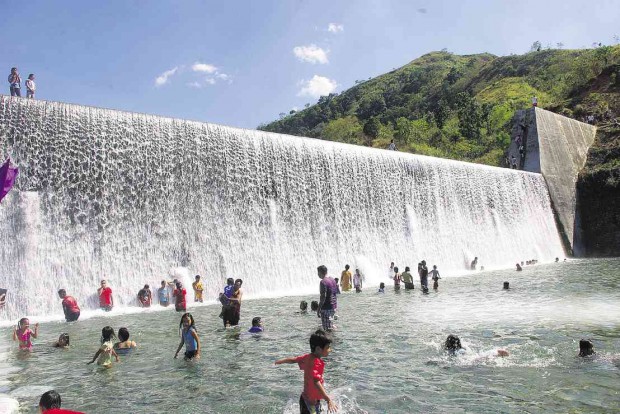In Ilocos Norte, tourists enjoy beauty of drying dams

THE MADONGAN River diversion dam in Dingras, Ilocos Norte has become a tourist attraction during the dry spell. LEILANIE ADRIANO
YOUNGSTERS trek to a sedimentary rock formation along a river in Dingras town in Ilocos Norte province. As soon as they reach the top, some leap into the water. Others enjoy the cool cascade of a waterfall from the Madongan River diversion dam in Barangay San Marcelino in Dingras.
Fevie Zaereel Bagcal, 8, of Laoag City, says swimming in crystal clear water is a real treat compared to the pool at the Ferdinand E. Marcos Sports Stadium where she learned to swim last summer.
The children, however, are oblivious to the dire condition of the facility. Rivers and streams that run through the dam have been drying up due to massive siltation and forest degradation.
The Madongan Dam located at the easternmost part of Dingras (502 kilometers north of Manila) has been dealing with a critical reduction of water. The water cascading down may not even last until the end of the dry season due to the dry spell.
Overdue rehabilitation
Article continues after this advertisementOld concrete dams like Madongan have yet to undergo their long overdue rehabilitation and repair of damaged intake tunnels, resulting in inadequate water supply during the dry season and affecting the village’s rice and corn production.
Article continues after this advertisementThe migrant Isnegs from Apayao province took this opportunity to build cottages made of light bamboo and cogon grass to rent out to visitors for P500.
Now on its second year of operation, Rubio Bangi, Barangay San Marcelino councilor representing the indigenous peoples, says they set up the cottages at the silted riverbeds so tourists could enjoy the waterfalls from the dam.
“This area used to be deep but perhaps due to massive soil erosion from the mountains, the river is now silted which enabled us to build these cottages,” he says.
Stalls were also put up to offer snacks and refreshments, sell souvenir items, and vegetables and orchids gathered from the mountains.
Norbert Calaoagan, village chair, says they are encouraging the Isneg community to develop this alternative enterprise, hoping to keep the remaining forest cover intact.
The Madongan Watershed Forest Reserve used to supply abundant water, which was generally used for irrigation. It was also the source of springs tapped for households.
Upland villagers, however, depend on forest resources, which is why the community is happy their indigenous Filipino neighbors decided to exploit the dam’s tourism potentials.
As the area draws more local and foreign tourists, Calaoagan has asked the provincial and municipal governments to improve the dirt road leading to Madongan Dam.
The community is also replenishing the forest by planting more trees and has discouraged people from undertaking slash and burn farming.
“Unlike us in the lowlands, the indigenous Filipino communities have limited land to farm and yet they are multiplying. We want them to benefit from their tourism venture, hoping to gain their full support in protecting our environment,” says Calaoagan.
Fixing the dams is still a priority for government. Provincial Board Member Albert Chua, chair of the committee on agriculture, says the board has passed a resolution requesting Agriculture Secretary Proceso Alcala to repair five national irrigation systems built in the 1980s covering the streams of Madongan, Papa, Labogaon, Cura and Solsona.